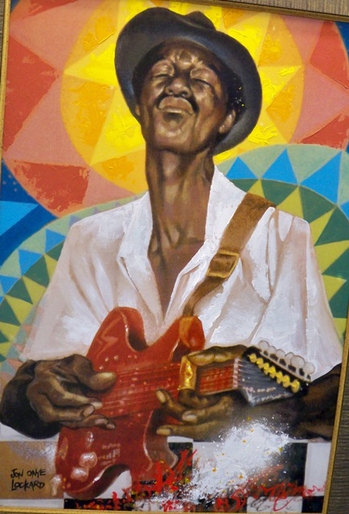Stunning U-M exhibit showcases Jon Onye Lockard's remarkable career

"Bluesman" by Jon Onye Lockard
Jon Onye Lockard is Southeast Michigan’s griot.
He’s our local storyteller analogous to the West African teller of tales whose purpose is to pass on designated customs, rituals, and tradition. This status can only be earned through one’s achievements.
Lockard’s “Africentricity” at the University of Michigan Center for Afroamerican and African Studies Gallery is essentially a career retrospective. And what a career it has been; spanning more than a half-century teaching, exhibiting, and lecturing locally, nationally, and internationally through his positions at Washtenaw Community College and the University of Michigan.
As Bamidele Agbasegbe Demerson, historical curator at Detroit’s Charles H. Wright Museum of African American History, tells us, “Lockard’s work, heritage, and destiny are inexorably linked as a perspective not only indigenous to the African American community, but also ultimately traceable to prototypical philosophical traditions in Africa.
“The art of Jon Onye Lockard,” says Demerson, “amplifies the often quoted folk wisdom of elderly African-Americans who remind us: ‘You don't know where you're going, if you don't know where you've been.’” And where Lockard has been spans Michigan’s history through the better part of the 20th century.
“Through his experiences,” concludes Demerson, “the dynamic of African-American urban life and a keen awareness of the significance of political struggle (have) become indelibly etched in Lockard’s worldview. And from this worldview his sense of artistic mission began to take shape, underscoring the enduring linkage between history, culture, and aesthetics.”
All of which, in turn, is amplified in Lockard’s own words when he says, “All art propagates and perpetuates the dynamic of a people, their ideals, religions, their successes and failures; their beauty, and even their foolishness.
“I believe we must recognize the past, function in the present, and prepare for the future all at the same time. I believe we must rediscover and record the role of our people, not only in America, but world history as well.”
This expansive view gives “Africentricity” its diverse range and emotional resonance. Some of Lockard’s 25 oil and acrylic paintings and/or giclee prints on display in the CAAS ground floor Mason Hall art gallery have been displayed locally through recent years. But it’s only in seeing a number of them together in such an intimate setting that Lockard’s outlook draws together into a unified whole.
In works like the acrylic paintings “King of Spades” and “Queen of Spades,” Lockard mingles history with his imagination. The “King of Spades” painting—a large face card drawn from a deck of cards—features a stoic Nelson Mandela in decorative African garb holding a handsome scepter as his emblem of authority.
By contrast, Lockard’s “Queen of Spades” is a regal figure of a whole other nature. Her authority within her community is unquestionably equal to the king; representing the power of the youthful matriarch—the eternal feminine—whose stature in any community conveys a sense of honor, blood, and continuity.
Yet Lockard’s worldview doesn’t look solely to the political. His acrylic “Bluesman” is all vibrant contemporary observation. The palette he adopts for this colorful painting captures his musician enraptured playing his guitar. Deeply attuned to his creativity, the bluesman’s eyes are tightly shut as he strains mightily at the sound only he hears and translates for others. And, as if to further revel in his musicality, Lockard paints a cascade of radiating red and green starbursts in the painting’s background.
Should there be any question about Lockard’s intention to tie together the historic past of the African-American community with the future, he’s added two paintings (“Simon of Cyrene” and “When I Lift My Garment, the Thunder will Roll”) whose historic circumstance bridges his devotion to yesterday with his intent to lend guidance for tomorrow.
Lockard’s magnificent oil and acrylic “Simon of Cyrene” is an inspired interpretation of this Biblical tale where Simon was said to be compelled by the Romans to carry the cross of Jesus Christ as he is led to his crucifixion. In this instance, the gospel’s dramatic narrative is abetted with a rich Afrocentric geometric pattern affixed to the wooden cross, reflecting devotion affixed to the historical circumstance of Simon being the first recorded African martyr to the Christian cause.
“When I Lift My Garment, the Thunder will Roll,” on the other hand, finds Lockard paying tribute to the spirit of nonconformity. The giclee print depicts an aged African-American woman seated facing her viewer with her knotty hands folded before her. Her eyes closed in rapt intent; Lockard’s aged matriarch is all coiled tension awaiting release. He’s suggests it’s the elder of the community that most represents its legacy as well as aspiration through experience and knowledge.
But if there’s a single painting in this exhibit that most effectively captures Lockard’s sentiments (effectively rivaling his world famed “Detroit/Soweto Pieta” also on display in this exhibition), it’s his mixed-media acrylic “Ah'm Gonna Raise This One Myself” dual portrait, in which a distinguished grandmother sits next to her grandson holding a clutch of music in her right hand.
In this painting, Lockard touches on his favorite themes: A rock solid past set next to the promising future as both matriarch and grandson represent a heightened optimism through culture and education. Lockard as girot has seen—and foresees—these things. And through his art, teaching, and example, he’s waged the earnest struggle of a lifetime to see them come about.
“Jon Onye Lockard: Africentricity” will continue through October 29 at the University of Michigan Center for Afroamerican and African Studies Gallery, G648 Haven Hall, 505 South State Street. Museum hours are 11 a.m. to 5 p.m., Friday. For information, call 734-764-5513.


Comments
seldon
Mon, Oct 11, 2010 : 12:29 p.m.
The word is "griot': http://en.wikipedia.org/wiki/Griot